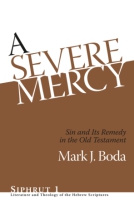A Severe Mercy
Sin and Its Remedy in the Old Testament
Mark J. Boda
The biblical-theological approach Boda takes in this work is canonical-thematic, tracing the presentation of the theology of sin and its remedy in the canonical form and shape of the Old Testament. The hermeneutical foundations for this enterprise have been laid by others in past decades, especially by Brevard Childs in his groundbreaking work. But A Severe Mercy also reflects recent approaches to integrating biblical understanding with other methodologies in addition to Childs’s. Thus, it enters the imaginative space of the ancient canon of the Old Testament in order to highlight the “word views” and “literary shapes” of the “texts taken individually and as a whole collection.” For the literary shape of the individual texts, it places the “word views” of the dominant expressions and images, as well as various passages, in the larger context of the biblical books in which they are found. For the literary shape of the texts as a collection, it identifies key subthemes and traces their development through the Old Testament canon. The breadth of Boda’s study is both challenging and courageous, resulting in the first comprehensive examination of the topic in the 21st century.
- Description
- Table of Contents
The biblical-theological approach Boda takes in this work is canonical-thematic, tracing the presentation of the theology of sin and its remedy in the canonical form and shape of the Old Testament. The hermeneutical foundations for this enterprise have been laid by others in past decades, especially by Brevard Childs in his groundbreaking work. But A Severe Mercy also reflects recent approaches to integrating biblical understanding with other methodologies in addition to Childs’s. Thus, it enters the imaginative space of the ancient canon of the Old Testament in order to highlight the “word views” and “literary shapes” of the “texts taken individually and as a whole collection.” For the literary shape of the individual texts, it places the “word views” of the dominant expressions and images, as well as various passages, in the larger context of the biblical books in which they are found. For the literary shape of the texts as a collection, it identifies key subthemes and traces their development through the Old Testament canon. The breadth of Boda’s study is both challenging and courageous, resulting in the first comprehensive examination of the topic in the 21st century.
1. Introduction
Part One: Torah
2. Genesis
3. Exodus
4. Leviticus (I)
5. Leviticus (II)
6. Numbers
7. Deuteronomy
8. Torah: Conclusion
Part Two: Prophets
9. Former Prophets: Joshua, Judges
10. Former Prophets: Samuel
11. Former Prophets: Kings
12. Isaiah
13. Jeremiah
14. Ezekiel
15. The Twelve (I)
16. The Twelve (II)
17. Prophets: Conclusion
Part Three: Writings
18. Proverbs
19. Job
20. Psalms (I)
21. Psalms (II)
22. Lamentations
23. Daniel
24. Ezra-Nehemiah
25. Chronicles
26. Writings: Conclusion
27. Conclusion
Works Cited
Mailing List
Subscribe to our mailing list and be notified about new titles, journals and catalogs.




